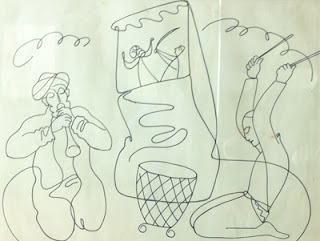 |
| Plate from the Picasso ceramic exhibition, Tashkent |
The back story of this exhibition is intriguing: after the death of French artist Fernand Léger in 1955, his Belarussian-born widow, Nadia Khodossevitch, donated many works from their private collection to the Soviet government. (Both Léger and Khodossevitch were communists).
The Soviet government distributed art works to museums throughout the USSR, and the 12 Picasso ceramics ended up in Tashkent, where they were exhibited in the 1960s. After that it seems they were placed in storage and, over time, forgotten. In 2004, while sorting through boxes, museum staff unearthed these priceless pieces.
 |
| Nadejda Kashina, Musicians, ink drawing |
Nadejda Kashina, whose drawings form part of this exhibition, was born in the Russian city of Perm in 1896 and moved to Tashkent in the late 1920s, after studying in Moscow. Kashina wrote that what attracted her in Central Asia were 'colouring, type and the huge amount of untouched topics'. Her Samarkand paintings in particular are bright and vibrant.
 |
| Nadejda Kashina, Woman with Star, ink drawing |
For travellers on Uzbek Journeys tours, you have a chance to view Kashina's avant-garde paintings at the Savitsky collection in Nukus.
As an interesting aside, the Savitksy collection includes 79 classical sculptures replicated for Léger in the Louvre, and given to Savitksy for his collection. Although not of particular interest to foreign visitors, this collection forms an important part of the Nukus museum's education program for schools.
Related posts: Paolo Veronese's Lamentation of Christ Discovered in Tashkent
Alexander Volkov: Of Sand and Silk
Igor Savitksy, Founder of the Karakalpakstan Museum, Nukus
Desert of Forbidden Art